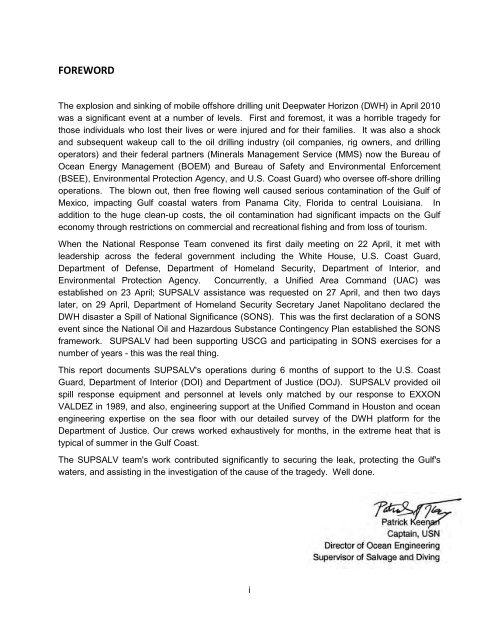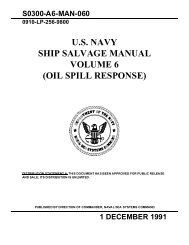- Page 1: SH285-AA-RPT-010 0910-LP-111-8218 U
- Page 6 and 7: Table of Contents 5-1.1 Gulfport Ba
- Page 8 and 9: FIGURE 5-18. SUPSALV EQUIPMENT STAG
- Page 10 and 11: Chapter 1: Introduction Figure 1-1-
- Page 12 and 13: Chapter 1: Introduction OPNAV Instr
- Page 14 and 15: Chapter 1: Introduction During the
- Page 17 and 18: Deepwater Horizon Oil Spill Respons
- Page 19 and 20: Deepwater Horizon Oil Spill Respons
- Page 21 and 22: Deepwater Horizon Oil Spill Respons
- Page 23 and 24: Deepwater Horizon Oil Spill Respons
- Page 25 and 26: Deepwater Horizon Oil Spill Respons
- Page 27 and 28: Deepwater Horizon Oil Spill Respons
- Page 29 and 30: Deepwater Horizon Oil Spill Respons
- Page 31 and 32: Deepwater Horizon Oil Spill Respons
- Page 33 and 34: Deepwater Horizon Oil Spill Respons
- Page 35 and 36: Deepwater Horizon Oil Spill Respons
- Page 37 and 38: Deepwater Horizon Oil Spill Respons
- Page 39 and 40: Deepwater Horizon Oil Spill Respons
- Page 41 and 42: Deepwater Horizon Oil Spill Respons
- Page 43 and 44: Deepwater Horizon Oil Spill Respons
- Page 45 and 46: Deepwater Horizon Oil Spill Respons
- Page 47 and 48: Deepwater Horizon Oil Spill Respons
- Page 49 and 50: Deepwater Horizon Oil Spill Respons
- Page 51 and 52: Deepwater Horizon Oil Spill Respons
- Page 53 and 54:
Deepwater Horizon Oil Spill Respons
- Page 55 and 56:
Deepwater Horizon Oil Spill Respons
- Page 57:
Deepwater Horizon Oil Spill Respons
- Page 60 and 61:
Chapter 6: Conclusion of Operation
- Page 62 and 63:
Chapter 6: Conclusion of Operation
- Page 65 and 66:
Deepwater Horizon Oil Spill Respons
- Page 67 and 68:
Deepwater Horizon Oil Spill Respons
- Page 69 and 70:
FINAL REPORT SONS DEEPWATER HORIZON
- Page 71 and 72:
Final Report, SONS Deepwater Horizo
- Page 73 and 74:
Final Report, SONS Deepwater Horizo
- Page 75 and 76:
Final Report, SONS Deepwater Horizo
- Page 77 and 78:
Final Report, SONS Deepwater Horizo
- Page 79 and 80:
Final Report, SONS Deepwater Horizo
- Page 81 and 82:
Final Report, SONS Deepwater Horizo
- Page 83 and 84:
Final Report, SONS Deepwater Horizo
- Page 85 and 86:
Final Report, SONS Deepwater Horizo
- Page 87 and 88:
Final Report, SONS Deepwater Horizo
- Page 89 and 90:
Final Report, SONS Deepwater Horizo
- Page 91 and 92:
Final Report, SONS Deepwater Horizo
- Page 93 and 94:
Final Report, SONS Deepwater Horizo
- Page 95 and 96:
Final Report, SONS Deepwater Horizo
- Page 97 and 98:
Final Report, SONS Deepwater Horizo
- Page 99 and 100:
Final Report, SONS Deepwater Horizo
- Page 101 and 102:
Final Report, SONS Deepwater Horizo
- Page 103 and 104:
Final Report, SONS Deepwater Horizo
- Page 105 and 106:
Final Report, SONS Deepwater Horizo
- Page 107 and 108:
Final Report, SONS Deepwater Horizo
- Page 109 and 110:
Final Report, SONS Deepwater Horizo
- Page 111 and 112:
Final Report, SONS Deepwater Horizo
- Page 113 and 114:
Final Report, SONS Deepwater Horizo
- Page 115 and 116:
Final Report, SONS Deepwater Horizo
- Page 117 and 118:
Final Report, SONS Deepwater Horizo
- Page 119 and 120:
Final Report, SONS Deepwater Horizo
- Page 121 and 122:
Final Report, SONS Deepwater Horizo
- Page 123 and 124:
Final Report, SONS Deepwater Horizo
- Page 125 and 126:
Final Report, SONS Deepwater Horizo
- Page 127 and 128:
Final Report, SONS Deepwater Horizo
- Page 129 and 130:
Final Report, SONS Deepwater Horizo
- Page 131 and 132:
Final Report, SONS Deepwater Horizo
- Page 133 and 134:
Final Report, SONS Deepwater Horizo
- Page 135 and 136:
Final Report, SONS Deepwater Horizo
- Page 137 and 138:
Final Report, SONS Deepwater Horizo
- Page 139 and 140:
Final Report, SONS Deepwater Horizo
- Page 141 and 142:
Final Report, SONS Deepwater Horizo
- Page 143 and 144:
Final Report, SONS Deepwater Horizo
- Page 145 and 146:
Final Report, SONS Deepwater Horizo
- Page 147 and 148:
Final Report, SONS Deepwater Horizo
- Page 149 and 150:
Final Report, SONS Deepwater Horizo
- Page 151 and 152:
Final Report, SONS Deepwater Horizo
- Page 153 and 154:
Final Report, SONS Deepwater Horizo
- Page 155 and 156:
Final Report, SONS Deepwater Horizo
- Page 157 and 158:
Final Report, SONS Deepwater Horizo
- Page 159 and 160:
Final Report, SONS Deepwater Horizo
- Page 161 and 162:
Final Report, SONS Deepwater Horizo
- Page 163 and 164:
Final Report, SONS Deepwater Horizo
- Page 165 and 166:
Final Report, SONS Deepwater Horizo
- Page 167 and 168:
Final Report, SONS Deepwater Horizo
- Page 169 and 170:
Final Report, SONS Deepwater Horizo
- Page 171 and 172:
Final Report, SONS Deepwater Horizo
- Page 173 and 174:
Final Report, SONS Deepwater Horizo
- Page 175 and 176:
Final Report, SONS Deepwater Horizo
- Page 177 and 178:
Final Report, SONS Deepwater Horizo
- Page 179 and 180:
Final Report, SONS Deepwater Horizo
- Page 181 and 182:
Final Report, SONS Deepwater Horizo
- Page 183 and 184:
Final Report, SONS Deepwater Horizo
- Page 185 and 186:
Final Report, SONS Deepwater Horizo
- Page 187 and 188:
Final Report, SONS Deepwater Horizo
- Page 189 and 190:
Final Report, SONS Deepwater Horizo
- Page 191 and 192:
Final Report, SONS Deepwater Horizo
- Page 193 and 194:
Final Report, SONS Deepwater Horizo
- Page 195 and 196:
Final Report, SONS Deepwater Horizo
- Page 197 and 198:
Final Report, SONS Deepwater Horizo
- Page 199 and 200:
Final Report, SONS Deepwater Horizo
- Page 201 and 202:
Final Report, SONS Deepwater Horizo
- Page 203 and 204:
Final Report, SONS Deepwater Horizo
- Page 205 and 206:
Final Report, SONS Deepwater Horizo
- Page 207 and 208:
Final Report, SONS Deepwater Horizo
- Page 209 and 210:
Appendix B Tasking and Funding Docu
- Page 211 and 212:
UNCLASSIFIED// R 281622Z APR 10 ZUI
- Page 213 and 214:
B-5
- Page 215 and 216:
B-7
- Page 217 and 218:
B-9
- Page 219 and 220:
B-11
- Page 221 and 222:
B-13
- Page 223 and 224:
B-15
- Page 225 and 226:
B-17
- Page 227 and 228:
Appendix C. Sample SITREPS SITREP #
- Page 229 and 230:
SYS # ESSM # EQUIPMENT GULF OIL SPI
- Page 231 and 232:
SUPSALV EQUIPMENT ‐ GULF OIL SPIL
- Page 233 and 234:
Issues/Concerns: NTR C‐7
- Page 235 and 236:
C‐9
- Page 237 and 238:
C‐11
- Page 239 and 240:
C‐13
- Page 241 and 242:
Appendix D. White Paper: Combined F
- Page 243 and 244:
The technical approach proposed is
- Page 245 and 246:
a. Analysis of an adjustable angle-
- Page 247 and 248:
UNDERSEA OPERATIONS REPORT USCG DEE
- Page 249 and 250:
UNDERSEA OPERATIONS REPORT USCG DEE
- Page 251 and 252:
USCG DEEP WATER HORIZON INVESTIGATI
- Page 253 and 254:
USCG DEEP WATER HORIZON INVESTIGATI
- Page 255 and 256:
USCG DEEP WATER HORIZON INVESTIGATI
- Page 257 and 258:
USCG DEEP WATER HORIZON INVESTIGATI
- Page 259 and 260:
USCG DEEP WATER HORIZON INVESTIGATI
- Page 261 and 262:
USCG DEEP WATER HORIZON INVESTIGATI
- Page 263 and 264:
USCG DEEP WATER HORIZON INVESTIGATI
- Page 265 and 266:
USCG DEEP WATER HORIZON INVESTIGATI
- Page 267 and 268:
USCG DEEP WATER HORIZON INVESTIGATI
- Page 269 and 270:
USCG DEEP WATER HORIZON INVESTIGATI
- Page 271 and 272:
USCG DEEP WATER HORIZON INVESTIGATI
- Page 273 and 274:
USCG DEEP WATER HORIZON INVESTIGATI
- Page 275 and 276:
USCG DEEP WATER HORIZON INVESTIGATI
- Page 277:
USCG DEEP WATER HORIZON INVESTIGATI

















